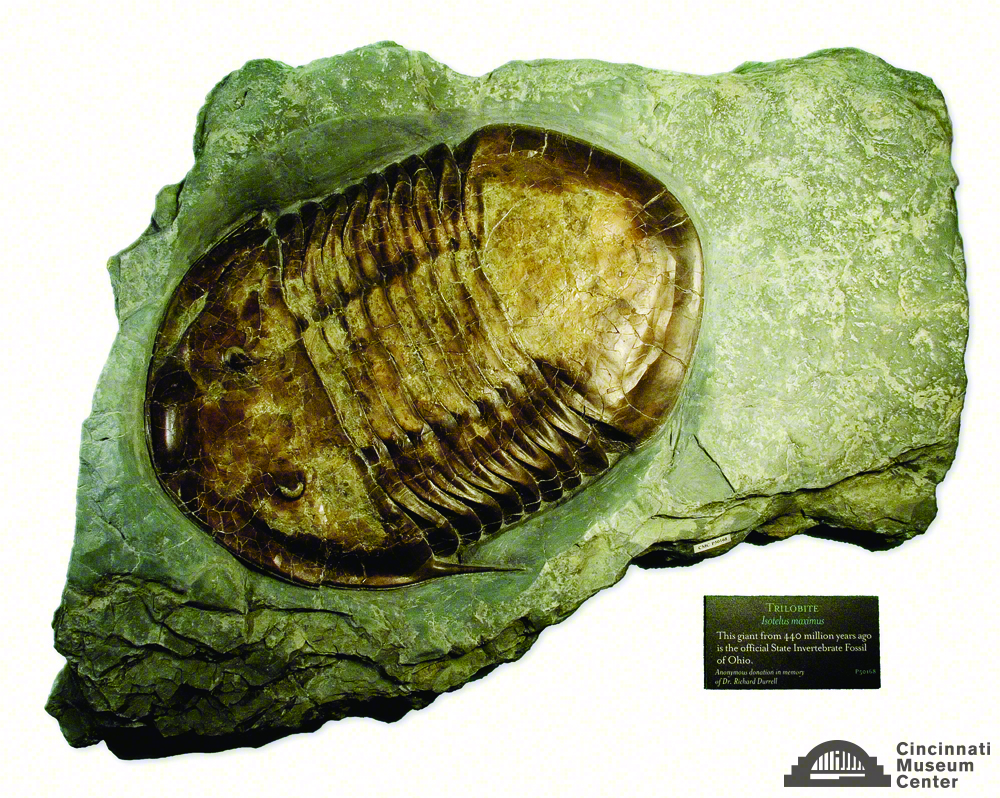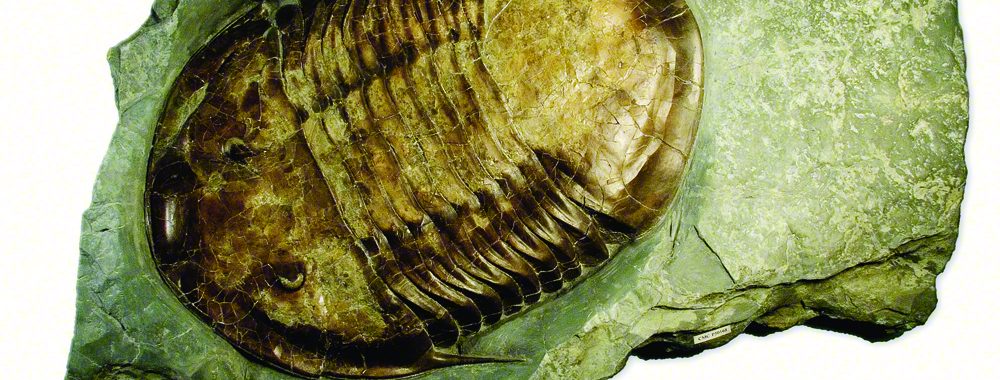
CMC Blog
Isotelus: Ohio State’s Fossil
By: Brenda Hunda, Curator of Invertebrate Paleontology

This is the largest complete trilobite specimen (“in captivity”) from the Cincinnati region. The world record is held by an Isotelus specimen from the Ordovician of Manitoba that measures 70 cm (27.6 “) long.CMC IP50168 - Isotelus maximus, Late Ordovician, Adams County, Ohio. Anonymous donation in memory of Dr. Richard Durrell. Shrake, D. 2005. Isotelus: Ohio’s State Fossil. Geofacts No 6, pgs. 1-2.
Meet your state representative. I am not referring to your state senator or your district representative. This is a representative of Ohio’s rich and significant paleontological past.
Isotelus, a Late Ordovician trilobite, was designated the official state invertebrate fossil of Ohio on June 20, 1985. After seeing a beautiful specimen of Isotelus at the Dayton Museum of Natural History (now known as the Boonschoft Museum of Discovery), third grade students from Beavertown School in Kettering, and fourth grade students from St. Anthony School in Dayton decided to try to get this trilobite designated as the official state fossil of Ohio. A letter campaign to Representatives Robert L. Corbin and Robert E. Hickey convinced them to sponsor legislation in the Ohio House of Representatives. Senator Charles Horn agreed to do the same in the Ohio Senate. Although the students wanted one particular specimen of Isotelus collected from Huffman Dam near Dayton in 1919 to represent Ohio, the genus Isotelus was designated as the official state invertebrate fossil (Shrake, 2005).
Trilobites are an extinct class of the Phylum Arthropoda. Although all trilobites went extinct 250 million years ago in the largest mass extinction event in Earth’s History – the Permo-Triassic Extinction Event – they were a major component of ancient marine communities for the previous 300 million years. Trilobites left no descendants, but they are most closely related to the chelicerate arthropods, to which horseshoe crabs, their modern analogue, belong. Like all arthropods, these animals grew by periodically shedding their exoskeletons. Trace fossil evidence suggests that Isotelus was a predator, crawling and burrowing on the seafloor looking for their favorite meal, worms. Isotelus is unique among trilobites in that it can attain very large size. The largest complete one in the Cincinnati Museum Center’s collection is 40 cm long, but the largest specimen of Isotelus in the world is 70 cm long, making it the largest trilobite ever discovered. Granted, this larger example belongs to a different species of Isotelus, and it is not found in our Cincinnatian rocks. CMC’s is the largest local specimen.
If collecting fossils in the southwestern region of Ohio, you will undoubtedly come across Isotelus exoskeletal remains preserved in the rocks. Fossils of Isotelus are ubiquitous in Cincinnati area deposits, although they are usually found as fragments rather than as complete specimens. These rock strata are exceptionally fossil-rich, scientifically valuable, and world famous. Limestone and shale deposits represent a time long ago in North American history, when most of the United States was under a warm tropical shallow ocean, the continent was located in the southern hemisphere and life on Earth was dominated by invertebrate animals (animals without backbones). The diversity (number of species) of animals is astounding, and their preservation is exquisite. Any fossil collector in the region knows that it is difficult to pick up a rock without a fossil in it! For scientists, these rocks, known as the Cincinnatian Series, provide an incredible window into life on Earth in deep time, some 450 million years ago. For all of these reasons and more, the Cincinnatian Series is the Type Area for the interval of geologic time known as the Late Ordovician Period (451 – 443 million years ago). This means that for this time interval, Cincinnati and the surrounding region have the best rocks and fossils to study in North America.
The history of research in this region is also illustrious, and Isotelus has had an important role to play in uncovering the scientific mysteries locked in these deposits. The Geological Survey of Ohio undertook the first serious scientific study of Ohio’s Ordovician rocks in 1873-1838 (Shrake, 2005). During this time, John Locke mapped portions of the southwestern corner of the state, discovering partial remains of a large specimen of Isotelus. Locke named it Isotelus maximus due to its large size. Only the pygidium (tail) of the animal was preserved, but based on proportions, he estimated the complete trilobite to be about 21 inches in length. Another specimen, the Huffman Dam specimen from which the original petition for official state fossil was made, fell into the hands of August F. Foerste (Shrake, 2005). Ultimately, Foerste’s specimen ended up at the Smithsonian National Museum of Natural History where it remains today.
Foerste was a Dayton-area high school teacher, a renowned and prolific paleontologist and an important member of the “Cincinnati School” of paleontology. The “Cincinnati School” was not a formal educational institution, but rather refers to a dedicated group of amateur paleontologists active in the Cincinnati area in the late 19th and early 20th centuries. Each was a passionate collector and scholar of Cincinnati fossils, and the fame of Cincinnati grew from the research publications of these “gentlemen naturalists.” All were associated with the Cincinnati Society of Natural History, a predecessor of Cincinnati Museum Center. Since the time of the “Cincinnati School,” many Cincinnatians have contributed to our understanding of the history of life. Today, the University of Cincinnati Department of Geology features one of America’s foremost paleontological programs. The Dry Dredgers, an award-winning association of amateur fossil collectors, and the longest running such group in the United States, is still going strong today. The extensive fossil collections of the Cincinnati Society of Natural History, The University of Cincinnati and many “Cincinnati School” and “Dry Dredgers” members, now reside at Cincinnati Museum Center and form the largest collection of Late Ordovician fossils in the world.
Isotelus is an exceptional choice for your state fossil representative. This trilobite fossil has played a pivotal role in the pursuit of scientific knowledge to understand the history of life in this region. Its scientific and historical importance is unparalleled in Ohio, and is a hallmark to the global significance of paleontological and geological resources in our state.
Museum Admission
Includes Cincinnati History Museum, Museum of Natural History & Science and The Children's Museum
| Adult: | $22.50 |
| Senior: | $15.50 |
| Child: | $15.50 |
| Member Adult: |
FREE |
| Member Child: |
FREE |
Members receive discounts!
Become a Member today to save on programs, exhibits and films throughout CMC.
Museum Hours
Open Thursday – Monday
10 a.m. to 5 p.m.
Closed Tuesday and Wednesday
Closed Thanksgiving Day and Christmas Day
Member’s-only early entry: Saturdays at 9 a.m.
Customer Service Hours:
Monday – Sunday, 9 a.m. to 5 p.m.

